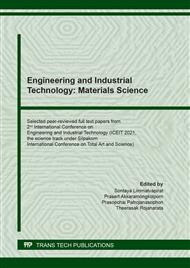p.3
p.9
p.15
p.23
p.31
p.37
p.45
p.53
Cold-Pressed Coconut Oil Cream: Preparation and Evaluation
Abstract:
Typically, the emollient effect of the vegetable oil has attributed to its usefulness in skin care preparation. The present study aims to prepare the oil in water emulsion cream containing virgin coconut oil (CO) comprisinghydrophilic and lipophilic surfactants (Tween 80 and Span 80). Stability of creams containing CO upon addition of peppermint oil (PO), co-surfactant (Solutol HS 15, ST), solubilizer (benzyl benzoate, BB) was investigated after the temperature cycling. All prepared creams showed the shear thinning flow behavior. Addition of BB gave the lowest viscosity while that comprising ST exhibited the higher viscosity. The highest viscosity formula was the CO andPO containing cream. The particle size determined using light scattering particle analyzer revealed that the mean particle size of all prepared creamswaslower than 35.56 ± 0.62 µm. The homogenous dispersion of oil globules in emulsion was evident, especially, in formulation II (CO) and IV (COand ST). Although the temperature cycling influenced more or less on the compact structure of gel network of cream, the decrement of viscositywasminimal and not much different for cream containing CO and ST (formulation IV). In addition, the mean particle size wasthe smallest for formulation II (CO) which was followed by formulation IV (CO and ST). There wasthe homogenous dispersion of oil globules in formulation II and IV after temperature cycling. All of the above finding was beneficial for employingCO as the oil phase in producing cream such as the foot massage cream where the addition of ST provided the better stability for the prepared cream containing CO.
Info:
Periodical:
Pages:
23-29
Citation:
Online since:
March 2022
Authors:
Keywords:
Price:
Сopyright:
© 2022 Trans Tech Publications Ltd. All Rights Reserved
Share:
Citation:


